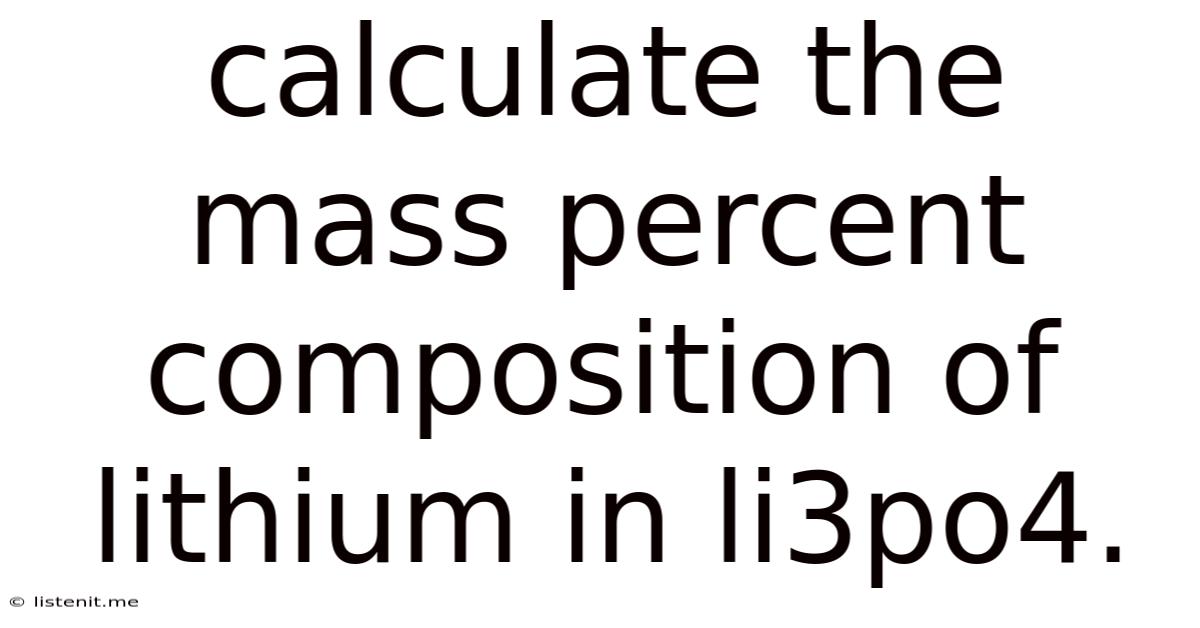Calculate The Mass Percent Composition Of Lithium In Li3po4.
listenit
May 09, 2025 · 4 min read

Table of Contents
Calculate the Mass Percent Composition of Lithium in Li₃PO₄
Determining the mass percent composition of an element within a compound is a fundamental concept in chemistry, crucial for various applications, from stoichiometric calculations to analyzing the purity of substances. This article will delve into the detailed process of calculating the mass percent composition of lithium (Li) in lithium phosphate (Li₃PO₄), providing a comprehensive understanding of the underlying principles and calculations involved. We'll also explore practical applications and related concepts to solidify your grasp of this important chemical calculation.
Understanding Mass Percent Composition
Mass percent composition, also known as weight percent composition, represents the mass of a specific element in a compound relative to the total mass of the compound, expressed as a percentage. It's a crucial tool for analyzing the elemental makeup of substances and plays a vital role in various chemical analyses and industrial processes. The formula for calculating mass percent composition is straightforward:
(Mass of element / Molar mass of compound) x 100%
Calculating the Molar Mass of Li₃PO₄
Before calculating the mass percent composition of lithium in Li₃PO₄, we must first determine the molar mass of lithium phosphate. This involves summing the atomic masses of each element present in the compound, taking into account the number of atoms of each element.
We'll use the following standard atomic masses:
- Li (Lithium): 6.94 g/mol
- P (Phosphorus): 30.97 g/mol
- O (Oxygen): 16.00 g/mol
Therefore, the molar mass of Li₃PO₄ is calculated as follows:
(3 × 6.94 g/mol) + (1 × 30.97 g/mol) + (4 × 16.00 g/mol) = 115.79 g/mol
Calculating the Mass Percent Composition of Lithium in Li₃PO₄
Now that we have the molar mass of Li₃PO₄, we can calculate the mass percent composition of lithium. This is done using the formula mentioned earlier:
(Mass of Lithium / Molar mass of Li₃PO₄) x 100%
The mass of lithium in one mole of Li₃PO₄ is:
3 atoms Li × 6.94 g/mol = 20.82 g/mol
Therefore, the mass percent composition of lithium in Li₃PO₄ is:
(20.82 g/mol / 115.79 g/mol) x 100% ≈ 17.98%
Thus, lithium constitutes approximately 17.98% of the total mass of lithium phosphate.
Step-by-Step Breakdown for Clarity
Let's break down the calculation into a more accessible, step-by-step format:
-
Identify the elements: Li₃PO₄ contains Lithium (Li), Phosphorus (P), and Oxygen (O).
-
Determine the number of atoms of each element: There are 3 Lithium atoms, 1 Phosphorus atom, and 4 Oxygen atoms.
-
Find the atomic mass of each element: Using a periodic table, we find the atomic masses: Li ≈ 6.94 g/mol, P ≈ 30.97 g/mol, O ≈ 16.00 g/mol.
-
Calculate the mass of each element in one mole of Li₃PO₄:
- Lithium: 3 atoms × 6.94 g/mol = 20.82 g
- Phosphorus: 1 atom × 30.97 g/mol = 30.97 g
- Oxygen: 4 atoms × 16.00 g/mol = 64.00 g
-
Calculate the molar mass of Li₃PO₄: 20.82 g + 30.97 g + 64.00 g = 115.79 g/mol
-
Calculate the mass percent of Lithium: (20.82 g / 115.79 g) × 100% ≈ 17.98%
-
State the result: The mass percent composition of lithium in Li₃PO₄ is approximately 17.98%.
Practical Applications and Significance
The ability to calculate mass percent composition has numerous practical applications across various fields:
-
Analytical Chemistry: Determining the purity of a sample. If a sample of Li₃PO₄ is analyzed and found to have a lower lithium percentage than 17.98%, it suggests the presence of impurities.
-
Stoichiometry: Mass percent composition is essential for stoichiometric calculations, which are crucial for determining the quantities of reactants and products in chemical reactions.
-
Material Science: Understanding the composition of materials is crucial for designing new materials with specific properties. Knowing the mass percent of each element helps tailor the properties of the material.
-
Geochemistry: Analyzing the composition of rocks and minerals to understand geological processes and resource exploration.
-
Environmental Science: Determining the concentration of pollutants in environmental samples.
Further Exploration: Calculating Mass Percentages of Other Elements
To further solidify your understanding, let's calculate the mass percent composition of phosphorus and oxygen in Li₃PO₄ using the same principles:
Phosphorus:
(30.97 g/mol / 115.79 g/mol) × 100% ≈ 26.73%
Oxygen:
(64.00 g/mol / 115.79 g/mol) × 100% ≈ 55.29%
As a check, the sum of the mass percentages should be approximately 100%: 17.98% + 26.73% + 55.29% ≈ 100% (Minor discrepancies may arise due to rounding).
Conclusion: Mastering Mass Percent Composition
Calculating the mass percent composition of elements in a compound is a fundamental skill in chemistry with wide-ranging applications. This article provided a detailed, step-by-step guide to calculating the mass percent of lithium in Li₃PO₄, along with practical applications and extensions to calculate the mass percentages of other elements. Mastering this concept is essential for anyone pursuing studies or working in fields involving chemistry, material science, or related disciplines. Remember to always double-check your calculations and use accurate atomic masses from a reliable source, such as a periodic table. By understanding these principles, you'll be better equipped to tackle more complex chemical calculations and gain a deeper understanding of the composition of matter.
Latest Posts
Latest Posts
-
Least Common Multiple Of 27 And 45
May 11, 2025
-
What Is The Measurement Of Angle L
May 11, 2025
-
How Does An Aneroid Barometer Work
May 11, 2025
-
6 Of 20 Is What Percent
May 11, 2025
-
Which Compound Has The Lowest Boiling Point
May 11, 2025
Related Post
Thank you for visiting our website which covers about Calculate The Mass Percent Composition Of Lithium In Li3po4. . We hope the information provided has been useful to you. Feel free to contact us if you have any questions or need further assistance. See you next time and don't miss to bookmark.